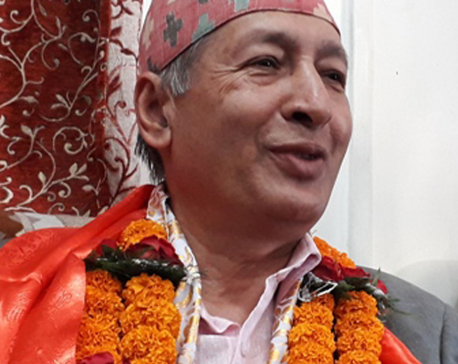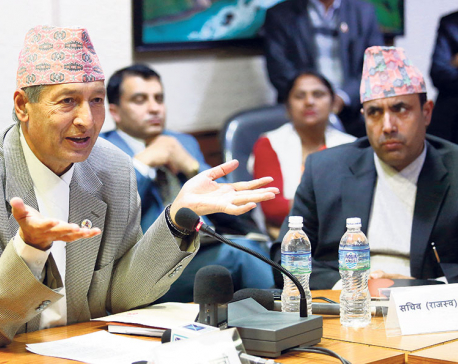
OR
Editorial
Ground Realities and Nepal’s Goal to Graduate from LDCs
Published On: March 4, 2023 07:45 AM NPT By: Republica | @RepublicaNepal

The economic outlook for the country appears grim, with a forecast that is anything but optimistic. However, despite political instability and a sluggish economy, the government reports that Nepali citizens are experiencing an increase in annual income! The National Planning Commission (NPC) has gone so far as to predict a remarkable 40.11 percent rise in per capita income for Nepalis, reaching USD 1,935 within the next four years. Yet, the sluggish pace of economic growth remains a formidable challenge for Nepal in achieving such lofty targets. Furthermore, graduating from its current LDC status to a middle-income country by 2026 is expected to be a particularly arduous undertaking for Nepal. The NPC's report, while ambitious, is not supported by other international organizations' research, such as that of the World Bank. The World Bank projects that Nepal's economic growth rate will continue to be sluggish, with only 5.1 percent growth predicted for the current fiscal year and a mere 4.9 percent in 2023/24, due to the global economic slowdown.
The slow pace of economic growth is not the only challenge that Nepal faces. There are signs of recession in all sectors, except for the banking and financial institutions. The impact of the slowdown is visible in the government's revenue collection, which has been revised down by Rs 244 billion. The impact is also visible in credit expansion; with businesses experiencing problems and demand falling.The first three months of the current fiscal year have been marked by sluggish economic growth, with the quarterly gross domestic product growth rate forecast by the National Statistics Office (NSO) measuring at less than one percent. The service sector growth data published by the NSO also shows that almost all sectors of the market have been affected since the beginning of the fiscal year. The impact of the economic slowdown is still visible this year, and the banking sector has been discouraged in credit expansion, while the demand is falling, and businesses are also experiencing problems.
Meanwhile, Nepal's economic indicators do not pose a healthy picture till date, and there is pressure on the economy since past couple of years. The impact of the recession is visible in all sectors except for the banking and financial institutions. The mining sector has been the most affected in the first three months of this year, and the production of the mineral sector has decreased by 29 percent this year. Similarly, the construction sector has been negative by 24 percent. The growth rate of the agricultural sector has been maintained at a meager 1.6 percent.
Clearly, the government's plan to upgrade Nepal to a middle-income country will be a tough one to fulfill with the current economic situation. However, it is important to note that there is no hurry for Nepal to graduate from its current LDC status. Shedding the current benefits and privileges it enjoys as an LDC in several world affairs including international trade and development assistance will not be easy. The country is still heavily dependent on international aid, and there are many areas where it needs support from the international community to achieve its development goals. The LDC status provides Nepal with access to preferential treatment in terms of trade and development assistance.
The current economic situation in Nepal requires a more realistic approach towards economic development. The government needs to focus on improving the infrastructure, promoting investment, and creating employment opportunities. It is also essential to promote exports, diversify the economy, and reduce the dependence on imports. The government must also prioritize social spending on health, education, and poverty reduction.
All in all, Nepal faces significant challenges in its quest to graduate from its current LDC status to the status of a middle-income country by 2026. The slow pace of economic growth, coupled with signs of recession in almost all sectorsmakes it challenging to achieve this goal. The government must take a more realistic approach to economic development and focus on revenue collection and job creation to address the challenges that Nepal faces. Graduating from LDC status may not be the best option for Nepal at this time, as the benefits and privileges that Nepal enjoys as an LDC are significant, and Nepal is not yet ready to shed them.
Nepal has been an LDC ever since this category of countries was created in 1971. So, the sky will not fall if it fails to graduate to a middle-income country in the next three-four years. No wonder if this is how the policymakers, too, take the great graduation goal for the time being!
You May Like This

No liquidity crisis in country: FM Khatiwada
MORANG, Nov 2: Minister for Finance Dr Yuvaraj Khatiwada has said that there was no liquidity crunch in the country. Read More...

Finance minister makes a diagnosis of economy
Slams privatization of public enterprises ... Read More...

Blockade institutionalized ‘black economy’: Experts
KATHMANDU, June 20: Experts said Monday that the five month long blockade not only fueled the black economy and corruption but... Read More...









Just In
- Heavy rainfall likely in Bagmati and Sudurpaschim provinces
- Bangladesh protest leaders taken from hospital by police
- Challenges Confronting the New Coalition
- NRB introduces cautiously flexible measures to address ongoing slowdown in various economic sectors
- Forced Covid-19 cremations: is it too late for redemption?
- NRB to provide collateral-free loans to foreign employment seekers
- NEB to publish Grade 12 results next week
- Body handover begins; Relatives remain dissatisfied with insurance, compensation amount








Leave A Comment